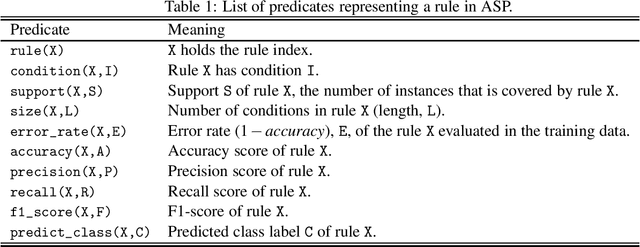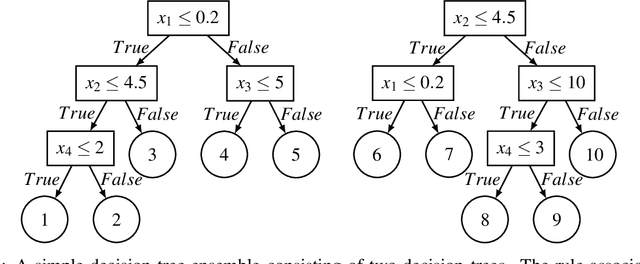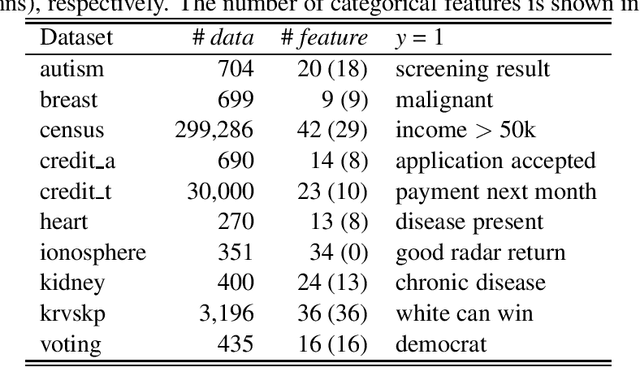Akihiro Takemura
Generating Global and Local Explanations for Tree-Ensemble Learning Methods by Answer Set Programming
Oct 14, 2024



Abstract:We propose a method for generating rule sets as global and local explanations for tree-ensemble learning methods using Answer Set Programming (ASP). To this end, we adopt a decompositional approach where the split structures of the base decision trees are exploited in the construction of rules, which in turn are assessed using pattern mining methods encoded in ASP to extract explanatory rules. For global explanations, candidate rules are chosen from the entire trained tree-ensemble models, whereas for local explanations, candidate rules are selected by only considering rules that are relevant to the particular predicted instance. We show how user-defined constraints and preferences can be represented declaratively in ASP to allow for transparent and flexible rule set generation, and how rules can be used as explanations to help the user better understand the models. Experimental evaluation with real-world datasets and popular tree-ensemble algorithms demonstrates that our approach is applicable to a wide range of classification tasks. Under consideration in Theory and Practice of Logic Programming (TPLP).
Differentiable Logic Programming for Distant Supervision
Aug 22, 2024Abstract:We introduce a new method for integrating neural networks with logic programming in Neural-Symbolic AI (NeSy), aimed at learning with distant supervision, in which direct labels are unavailable. Unlike prior methods, our approach does not depend on symbolic solvers for reasoning about missing labels. Instead, it evaluates logical implications and constraints in a differentiable manner by embedding both neural network outputs and logic programs into matrices. This method facilitates more efficient learning under distant supervision. We evaluated our approach against existing methods while maintaining a constant volume of training data. The findings indicate that our method not only matches or exceeds the accuracy of other methods across various tasks but also speeds up the learning process. These results highlight the potential of our approach to enhance both accuracy and learning efficiency in NeSy applications.
Towards end-to-end ASP computation
Jun 13, 2023



Abstract:We propose an end-to-end approach for answer set programming (ASP) and linear algebraically compute stable models satisfying given constraints. The idea is to implement Lin-Zhao's theorem \cite{Lin04} together with constraints directly in vector spaces as numerical minimization of a cost function constructed from a matricized normal logic program, loop formulas in Lin-Zhao's theorem and constraints, thereby no use of symbolic ASP or SAT solvers involved in our approach. We also propose precomputation that shrinks the program size and heuristics for loop formulas to reduce computational difficulty. We empirically test our approach with programming examples including the 3-coloring and Hamiltonian cycle problems. As our approach is purely numerical and only contains vector/matrix operations, acceleration by parallel technologies such as many-cores and GPUs is expected.
Generating Explainable Rule Sets from Tree-Ensemble Learning Methods by Answer Set Programming
Sep 17, 2021



Abstract:We propose a method for generating explainable rule sets from tree-ensemble learners using Answer Set Programming (ASP). To this end, we adopt a decompositional approach where the split structures of the base decision trees are exploited in the construction of rules, which in turn are assessed using pattern mining methods encoded in ASP to extract interesting rules. We show how user-defined constraints and preferences can be represented declaratively in ASP to allow for transparent and flexible rule set generation, and how rules can be used as explanations to help the user better understand the models. Experimental evaluation with real-world datasets and popular tree-ensemble algorithms demonstrates that our approach is applicable to a wide range of classification tasks.
* In Proceedings ICLP 2021, arXiv:2109.07914
 Add to Chrome
Add to Chrome Add to Firefox
Add to Firefox Add to Edge
Add to Edge